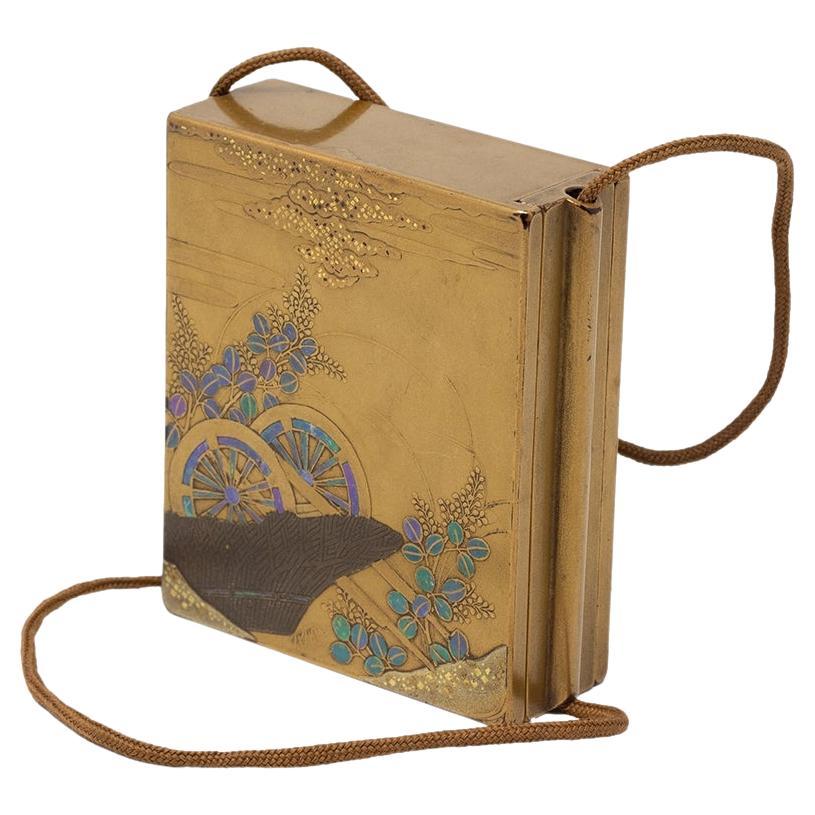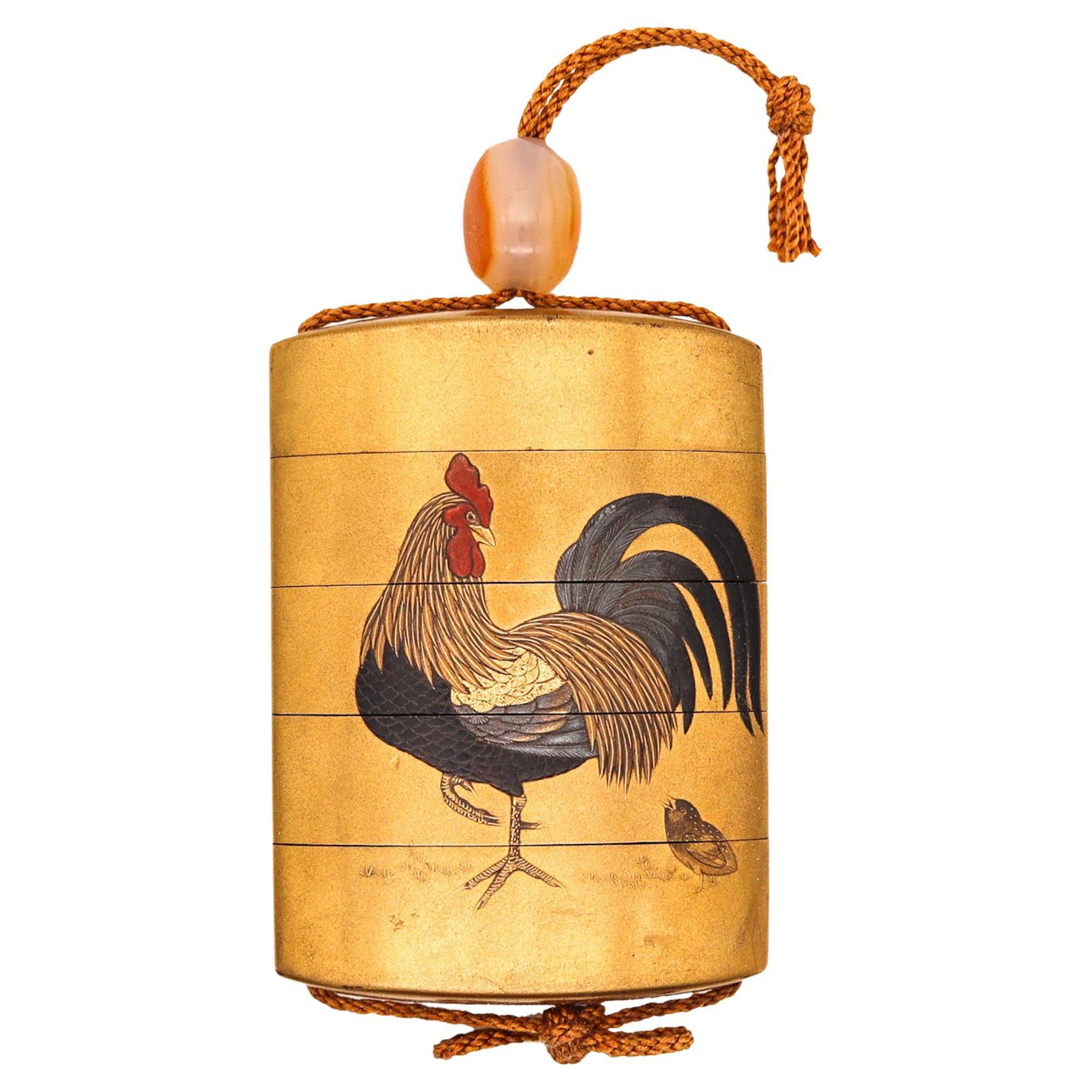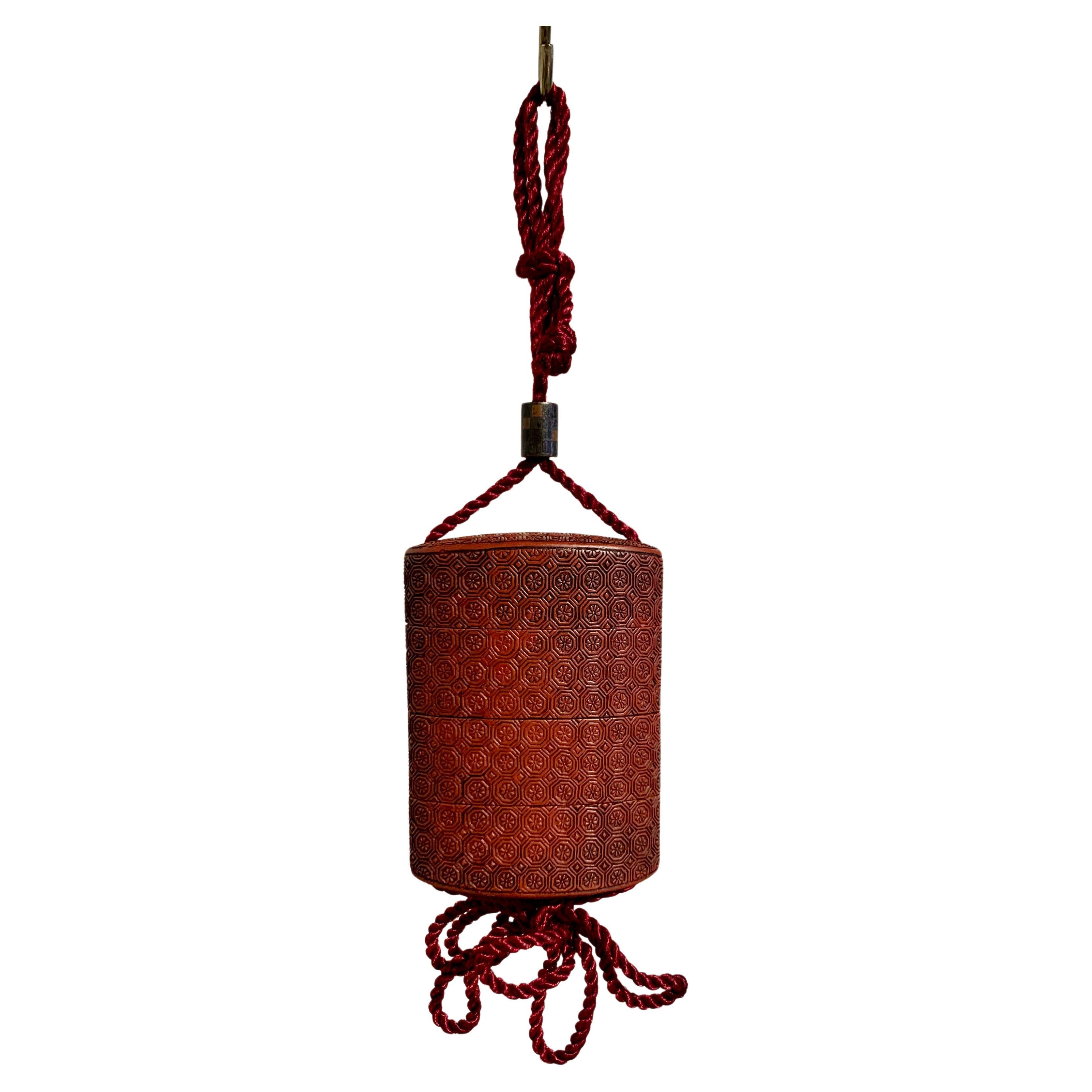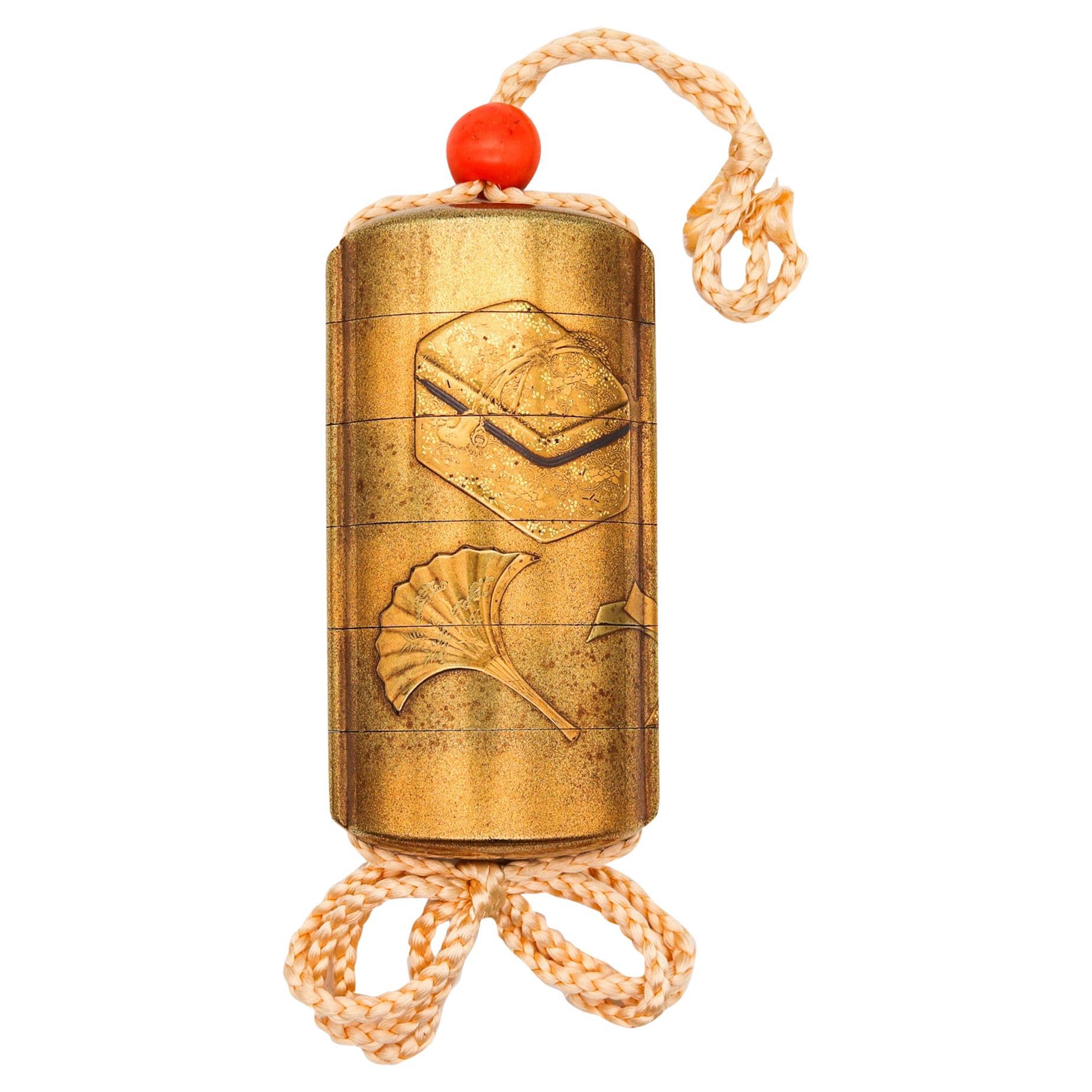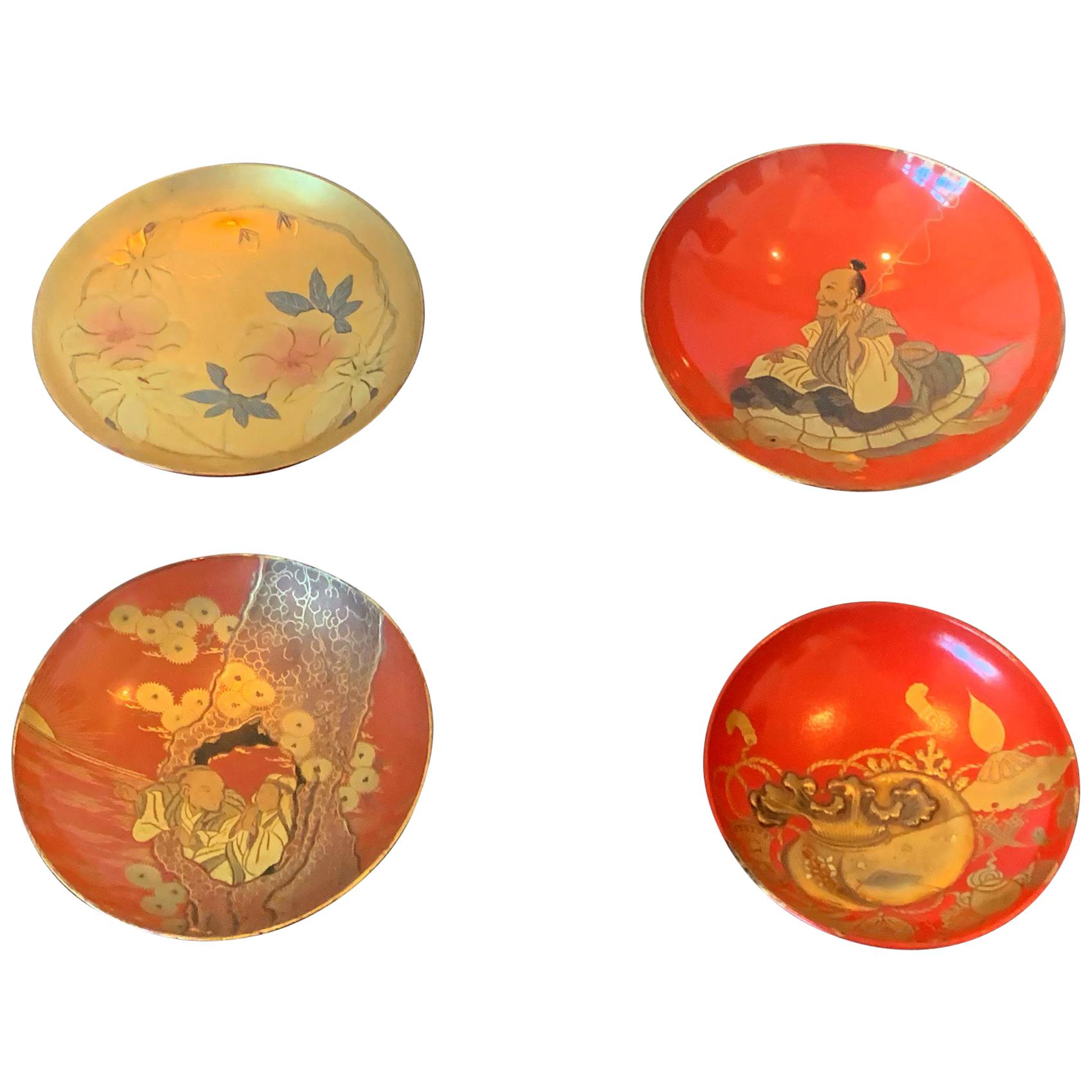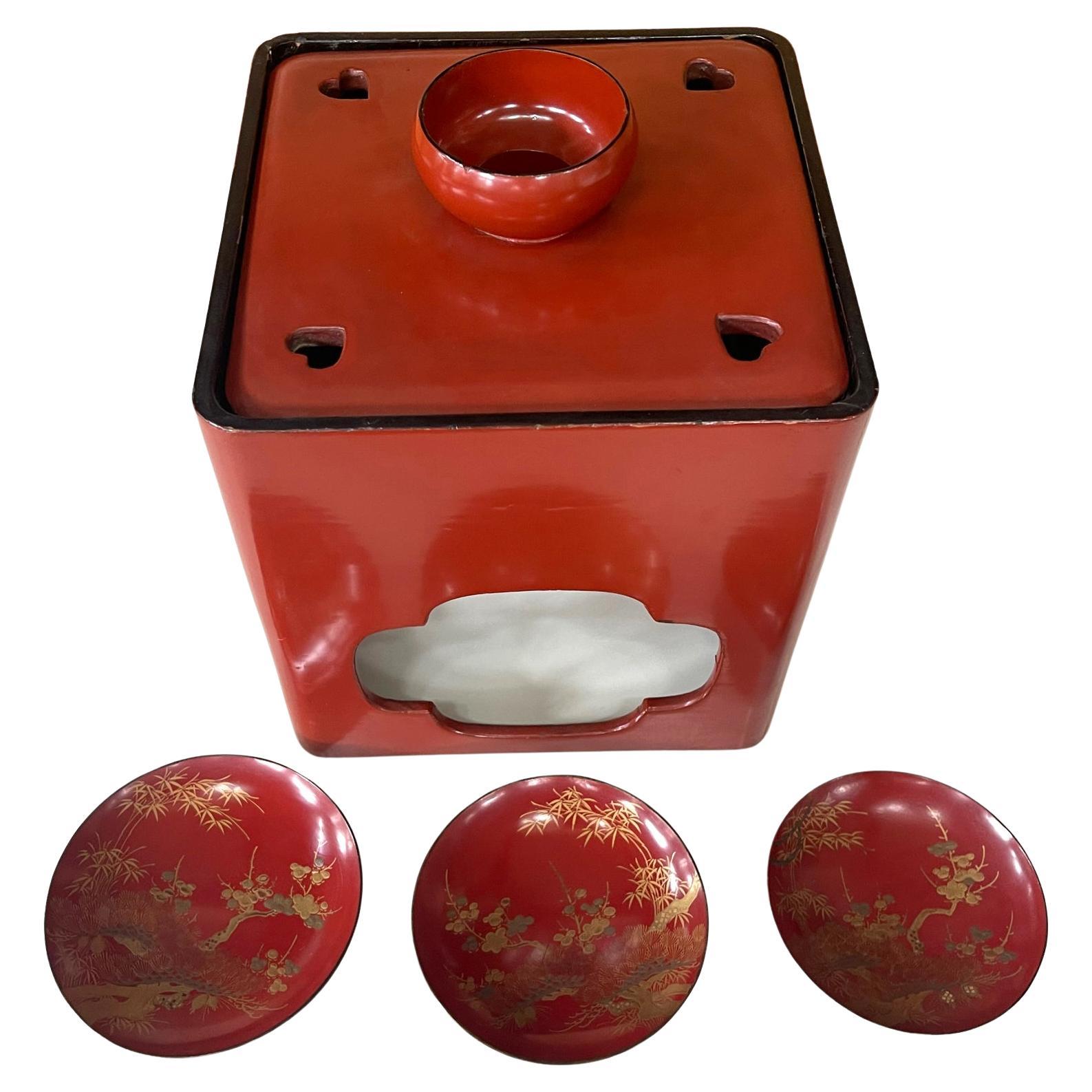Items Similar to Japan 1870 Meiji Period Round Five Drawer Inro Lacquered Wood With Flying Cranes
Want more images or videos?
Request additional images or videos from the seller
1 of 7
Japan 1870 Meiji Period Round Five Drawer Inro Lacquered Wood With Flying Cranes
About the Item
Japanese Inro from the Meiji Period (1868-1912).
Beautiful Inro, created in Japan during the Meiji imperial period, circa 1870. It was carefully crafted in carved precious wood with applications of lacquer and decorated with orientalism patterns. All dan trays are attached together with a himo cord. The detailed craftsmanship was a true pleasure to behold.
Period: Meiji 1868-1912, Period of Emperor Mutsuhito.
Approximate Date: 1870.
Motif: Organic design with cascade landscape scene and five flying cranes.
Drawers: Five.
Shape: Cylinder. Very unusual and rare shape.
Technique: Carved wood, Lacquer, hiramaki-e, takamaki-e, Gilding.
Ojime: 17mm, round with Ebony wood.
Netsuke: Carved dressed standing monk with a hat and holding a bag.
Weight: 46.60 Grams.
Measurements: Inro diameter of 30 mm, height of 78 mm (1.18 x 3.07 Inches)..
Meiji Period
This was an era of Japanese history that extended from October 23, 1868 to July 30, 1912.The Meiji era was the first half of the Empire of Japan, when the Japanese people moved from being an isolated feudal society at risk of colonization by Western powers to the new paradigm of a modern, industrialized nation state and emergent great power, influenced by Western scientific, technological, philosophical, political, legal, and aesthetic ideas. As a result of such wholesale adoption of radically different ideas, the changes to Japan were profound, and affected its social structure, internal politics, economy, military, and foreign relations. The period corresponded to the reign of Emperor Meiji. It was preceded by the Keiō era and was succeeded by the Taishō era, upon the accession of Emperor Taishō.
Inro
Is a traditional Japanese case for holding small objects, suspended from the obi (sash) worn around the waist when wearing a kimono. They are often highly decorated with various materials such as lacquer and various techniques such as maki-e, and are more decorative than other Japanese lacquerware. Because traditional Japanese dress lacked pockets, objects were often carried by hanging them from the obi in containers known as sagemono (a hanging object attached to a sash). Most sagemono were created for specialized contents, such as tobacco, pipes, writing brush and ink, but the type known as inro is suitable for carrying small things, and was created in the Sengoku period (1467–1615) as a portable identity seal and medicine container for travel. In the middle of the Edo period (1603–1868), inro became popular as men's accessories, and wealthy merchants of the chōnin and samurai classes collected inro often beautifully decorated with lacquer. As the technique developed from the late Edo period to the Meiji period (1868–1912) and the artistic value of inro increased, inro were no longer used as an accessory and came to be regarded as an art object for collection.
Ojime: An ojime (緒締め), lit. is a bead cord fastener used in Japanese inrō (carrying cases). It is typically under an inch in length. Each is carved into a particular shape and image, similar to the netsuke, though smaller.
Netsuke: A netsuke (根付, [netsɯ̥ke]) is a miniature sculpture, originating in 17th century in Japan. Initially a simply carved button fastener on the cords of an inrō box, netsuke later developed into ornately sculpted objects of craftsmanship.
Collateral: This piece is accompanied by a presentation pouch.
Condition: The overall condition of this Inro is excellent. Beside the little normal wear, there is no damage to any part. All part are original and secured. This piece has been carefully inspected to guarantee the condition and authenticity.
INVENTORY REF: D070523RCEH/.1111
- Dimensions:Height: 3.07 in (7.8 cm)Diameter: 1.18 in (3 cm)
- Style:Meiji (Of the Period)
- Materials and Techniques:
- Place of Origin:
- Period:
- Date of Manufacture:1870
- Condition:Wear consistent with age and use. The overall condition of this Inro is excellent. Beside the little normal wear, there is no damage to any part. All part are original and secured. This piece has been carefully inspected to guarantee the condition and authenticity.
- Seller Location:Miami, FL
- Reference Number:
About the Seller
5.0
Platinum Seller
These expertly vetted sellers are 1stDibs' most experienced sellers and are rated highest by our customers.
1stDibs seller since 2023
63 sales on 1stDibs
Typical response time: <1 hour
- ShippingRetrieving quote...Ships From: Miami, FL
- Return PolicyA return for this item may be initiated within 1 day of delivery.
More From This SellerView All
- Japan 1810 Kajikawa Edo Period Five Drawer Inro Lacquered Gilt Wood With RoosterLocated in Miami, FLJapanese Inro from the Edo period (1615-1868) created by Kajikawa. Beautiful Inro, created in Japan by one of the Kajikawa family during the Edo period (1615-1868), circa 1810. Has been carefully crafted in carved precious wood with applications of gilding maki-e and decorated with Japonism patterns. All dan trays are attached together with a himo cord. The detailed craftsmanship was a true pleasure to behold. Period: Edo period (1615-1868). Shogunate. Approximate Date: 1790-1810 Motif: A family of birds consisting of a cockerel, the hen and three chicks. Drawers: Five. Shape: Rectangular navette. Technique: Carved wood, lacquer and decorated in iroe-hiramaki-e on a gold ground. Ojime: 15mm 20mm, oval carved from natural translucent agate. Netsuke: None Weight: 47.70 Grams. Measurements: Inro is 78 mm by 55 mm by 18 mm (3.07 x 2.17 x 0.71 Inches). Signatures: Kajikawa Saku, in the underside with the signature KAJIKAWA. By a member of the Kajikawa family, signed Kajikawa 梶川 Japan, late 18th century to early 19th century, Edo period (1615-1868). The Kajikawa family Kajikawa family, flourished in the 19th century, they was Japanese lacquerware artists whose school in Edo (now Tokyo) flourished for more than 200 years. This family is perhaps the most famous of all the dynasties of Japanese lacquer artists, and certainly the name most often found on inro. The family is said to have been founded by Hikobei at Edo in the early 17th century, although some claim that the family’s great reputation really stemmed from his son and pupil Kyujiro. In any event, Hikobei worked for the shogunate, as did his successors until well into the 19th century. Kijirō excelled in designing particularly delicate lacquer inrō, portable medicine cases...Category
Antique 1810s Japanese Edo Lacquer
MaterialsAgate, Gold
- Japan 1800 Edo Period Six Drawer Inro In Lacquered Gilt Wood With UtensilsLocated in Miami, FLJapanese Inro from the Edo Period (1603-1867). Beautiful Inro, created in Japan during the Edo period (Shogunate), circa 1800. It was carefully crafted in carved precious wood with ...Category
Antique Early 1800s Japanese Edo Lacquer
MaterialsCoral
- Japan 1900 Meiji Miniature Hanagamidai Cabinet in Gilded Wood & Sterling SilverLocated in Miami, FLMiniature hanagamidai cabinet from the Japan meiji (1858-1912) period. Gorgeous and rare miniature drawers hanagamidai (cosmetic cabinet), created in the imperial Japan during the...Category
Antique Early 1900s Japanese Meiji Lacquer
MaterialsGold, Silver, Sterling Silver
- Japan 18th Century Edo Period Five Drawer Inro Lacquered Gilt Wood With RoosterLocated in Miami, FLJapanese Inro from the Edo period (1615-1868) Beautiful Inro, created in Japan during the Edo (1615-1868) Shogunate period circa Late 18th century. It was carefully crafted in carve...Category
Antique 18th Century Japanese Edo Antiquities
MaterialsSilver
- Japan 1890 Meiji Period Decorative Vase In Cloisonné Enamel With Wood BaseLocated in Miami, FLJapanese vase from the Meiji Period (1868-1912). Beautiful antique decorative vase, created in Japan during the Meiji period (1868-1912), circa 1890s. It was carefully crafted in so...Category
Antique 1890s Japanese Meiji Metalwork
MaterialsBronze, Enamel
- Japan 1900 Meiji Period Charger With A Dragon In Cloisonné Multicolor EnamelLocated in Miami, FLLarge charger in cloisonné from imperial Japan. Beautiful piece of Japanese decorative arts, created during the Meiji imperial period, circa ...Category
Antique Early 1900s Japanese Meiji Metalwork
MaterialsBronze, Copper, Enamel
You May Also Like
- Japanese Meiji Period Lacquer Six Drawer InroLocated in Newark, EnglandThe Inro is decorated with a gold lacquer base and features mother of pearl shell inlay leaves surounding wheeled cart with foliage. The Inro with a slide action opening which hides ...Category
Antique Late 19th Century Japanese Meiji Lacquer
MaterialsRope, Lacquer
- Japanese Carved Cinnabar Lacquer Inro, Meiji Period, late 19th c, JapanLocated in Austin, TXA good Japanese carved cinnabar three case inro with mixed metal ojime, Meiji period, late 19th century, Japan. The three case inro of standard form, comprised of three container se...Category
Antique Late 19th Century Japanese Meiji Lacquer
MaterialsSilver, Copper
- Four Japanese Lacquered Sake Cups Meiji PeriodLocated in Atlanta, GAAn assemble of four lacquerware sake cups from Meiji period Japan circa late 19th century. The shadow cups on an elevated stem were used by the nobles during ...Category
Antique Late 19th Century Japanese Meiji Lacquer
MaterialsWood, Lacquer
- Japanese Lacquered Sake Drinking Set Meiji PeriodLocated in Atlanta, GAA Japanese lacquered Sake Drinking set circa late 19th century (end of Meiji period), The assemble consists of a red lacquer stand open frame support and a lid that encloses a storage space with black lacquered interior. The lid features a and a cup holder in the center and four heart shape cutouts on the corners. There are three maki-e decorated sake cups with gradual sizes. The cups showcase on the red background elaborate gold hiramaki-e paintings...Category
Antique Late 19th Century Japanese Meiji Lacquer
MaterialsWood, Lacquer
- Japanese Maki-e Lacquer Stacking Box, Jubako, Meiji Period, JapanLocated in Austin, TXA fine and impressive Japanese gold maki-e decorated black lacquer five-tier jubako with presentation tray, two lids, and the original tomobako storage box, Meiji period, late 19th c...Category
Antique Late 19th Century Japanese Meiji Lacquer
MaterialsLacquer
- Pair of Two Japanese Antique Maki-e Lacquer Round Trays, Meiji periodLocated in Chuo-ku, TokyoJapanese lacquer tray with the wild goose, reed, and wave design. This pair of tray is a fine example of multiple lacquer techniques using gold, hiramaki-e, takamaki-e, and togidashi...Category
Antique 19th Century Japanese Meiji Lacquer
MaterialsWood, Lacquer
Recently Viewed
View AllMore Ways To Browse
Indian Wood Angels
Japanese Tanzaku
Negoro Tray
Stacking Lunch Box
Hasami Bako
Lacquer Hsunok
Suzuki Silver
African Wand
Japanese Hokkai Box
Midcentury Black Lacquer Inlay Wall Art
Peranakan Mirror
Rabbit Netsuke Ojime
Sake Storage Container
Tetsuya Yamada
Japanese Lacquer Pearl
Antique Asian Food Box
Japanese Sake Set Antique
Chinese Red Cinnabar Box
